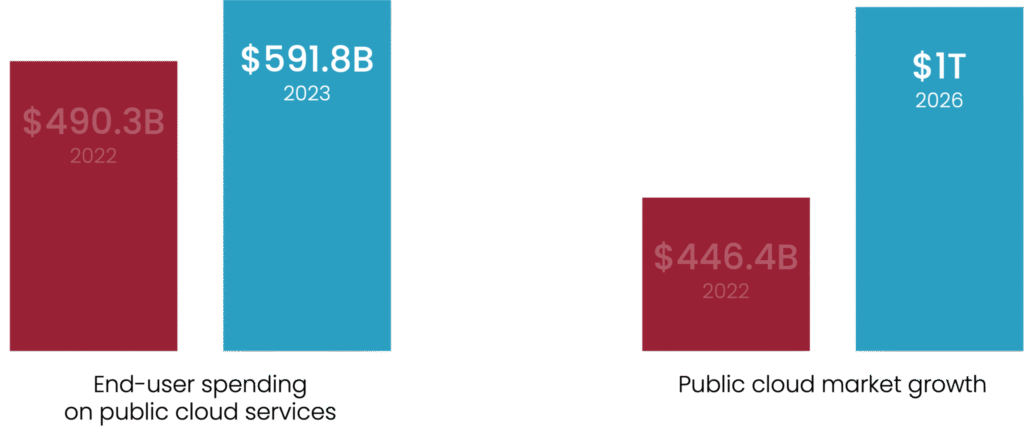We previously reviewed key themes that will play into an organization’s multi-cloud journey in Part 1. Now let’s look at cloud spend trends and predictions.
PART 2
Gartner forecasts worldwide end-user spending on public cloud services will grow 20.7% to total $591.8 billion in 2023, up from $490.3 billion in 2022. This is higher than the 18.8% growth forecast for 2022.
Forrester estimates the market will more than double from $446.4 billion in 2022 to cross the $1 trillion mark by 2026, seeing continued growth at a similar 20% plus rate.

With this steady growth in public cloud consumption globally, every CSP (cloud service provider) continues to launch innovative new offerings and enhance existing services every 6-18 months. One of the critical drivers to these more unique offerings is that organizations can see the disruption cloud technologies can offer to support complex digital transformation challenges that weren’t feasible before.
As a result, adopting multi-cloud strategies has become increasingly popular among organizations to mitigate risks and take advantage of unique features and pricing models offered by different cloud providers. However, an organization’s designated CCOE (Cloud Center of Excellence) team must carefully consider the cost implications of a multi-cloud strategy to ensure that the benefits outweigh the costs.
Costs – People, Process, Technology
One of the main cost implications of a multi-cloud strategy is the added complexity in managing and optimizing resources across multiple platforms. This can lead to increased costs in terms of personnel, tools, and processes required to manage and monitor the different environments. Additionally, the cost of data transfer and communication between different cloud platforms can also add up, especially for organizations with large amounts of data that need to be moved regularly.
Each cloud provider has its own unique services, pricing models, and terms of service, which can make it difficult for organizations to move workloads between different platforms. This can result in organizations being forced to pay more for certain services or being locked into a particular provider for a longer period of time.
Regulatory and Compliance
Organizations must also consider regulatory and compliance implications of a multi-cloud strategy. Different cloud providers may have different levels of compliance and security controls, which can make it difficult for organizations to ensure that they are meeting all of the necessary regulatory requirements. This can lead to increased costs in terms of compliance and security measures.
Cost Comparison Example
Here is a sample cost comparison of a multi-cloud strategy versus a single cloud strategy:
Multi-cloud Strategy
| Cloud Provider A | Cloud Provider B | Cloud Provider C | Total Cost |
| $10,000/month Computing resources + storage | $6,000/month Specialized services + data transfer costs | $4,000/month Disaster recovery + backup services | $20,000/month |
Single Cloud Strategy
| Cloud Provider A | Total Cost |
| $16,000/month All computing resources, storage, specialized services, data transfer, disaster recovery, and backup services | $16,000/month |
In this scenario, the multi-cloud strategy has a higher monthly cost than the single cloud strategy. However, it’s important to note that this is just a sample comparison, and actual costs will vary depending on the specific needs and requirements of the organization. Additionally, the multi-cloud strategy may offer other benefits such as increased flexibility, improved disaster recovery, and reduced risk of vendor lock-in that may outweigh the additional costs.
It is also worth noting that this comparison assumes that all the services needed can be found in one cloud provider, which is not always the case. Some of the services required may only be available in a certain cloud provider, so the best option is to use multiple cloud providers to get all necessary services.
It is also important to consider the long-term costs when comparing multi-cloud and single cloud strategies. While initial costs may be higher for a multi-cloud strategy, the ability to take advantage of unique features and pricing models offered by different cloud providers can lead to significant savings over time.
Everyone’s Journey is Different
Ultimately, the decision whether to use a multi-cloud or single cloud strategy will depend on the specific needs and requirements of the organization, and it’s important for organizations to carefully consider the costs and benefits of each option before making a decision.
In conclusion, a multi-cloud strategy can bring many benefits to organizations, but it is important to carefully consider cost implications before implementing one. By taking into account the costs, added complexity, vendor lock-in, and regulatory compliance implications, organizations can make an informed decision on whether a multi-cloud strategy is the right fit for their needs.

By Josh Petla, Cloud Practice Leader

